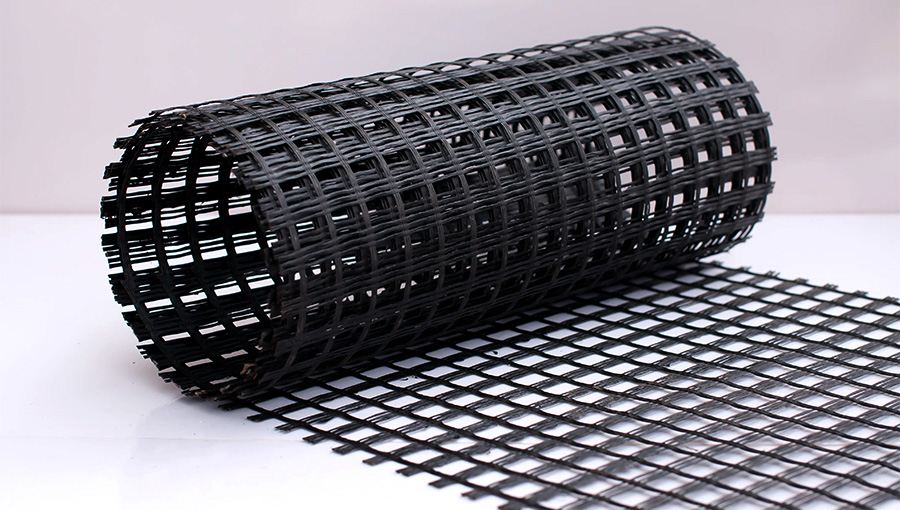1. Slow down reflection cracks
① Reflective cracks are caused by the stress concentration in the asphalt overlay above the old concrete surface due to the large displacement of the old concrete surface near the joints or cracks. It includes the horizontal displacement caused by changes in temperature and humidity, and the The vertical shear displacement caused by the load. The former results in a relatively concentrated tensile stress in the asphalt overlay above the joint or crack; the latter causes the asphalt overlay above the joint to experience greater flexural tensile stress and shear stress.
②Because the modulus of the geogrid is very large, reaching 67Gpa, it is used as a hard interlayer with high rigidity in the asphalt overlay. Its function is to restrain stress and release strain. At the same time, it is used as asphalt concrete reinforcement material to improve the structure of the overlay The tensile and shear resistance can be reduced to achieve the purpose of reducing cracks. Practice has shown that the corresponding crack energy of a horizontal crack that has changed direction can be moved 0.6 meters from its starting point, and reinforcement materials with a width of more than 1.5 meters help ensure that the energy is completely dissipated on both sides of the crack.
2. Anti-fatigue cracking
①The main function of the asphalt overlay on the old cement concrete pavement is to improve the use function of the pavement, but it does not contribute much to the bearing effect. The rigid concrete pavement under the overlay still plays a key bearing role. The asphalt overlay on the old asphalt concrete pavement is different, the asphalt overlay will carry the load together with the old asphalt concrete pavement. Therefore, in addition to reflection cracks, fatigue cracks will also occur due to the long-term effect of loads when asphalt overlay is performed on asphalt concrete pavements. We do a stress analysis on the load condition of the asphalt overlay on the old asphalt concrete pavement: since the asphalt overlay is a flexible surface with the same properties as the asphalt overlay, when subjected to load, the road surface will bend. Shen. The asphalt surface layer directly in contact with the wheel is under pressure, and in the area other than the wheel load edge, the surface layer is under tension. Since the force properties of the two stressed areas are different and they are close to each other, the The junction of the force area, that is, the sudden change of force, is prone to damage. Fatigue cracking occurs under long-term loading.
② The fiberglass geogrid can disperse the above-mentioned compressive stress and tensile stress in the asphalt surface layer, and form a buffer zone between the two stressed areas, where the stress changes gradually instead of abruptly, reducing the impact of sudden stress on the Destruction of asphalt overlays. At the same time, the low elongation of the glass fiber geogrid reduces the deflection of the pavement and ensures that the pavement will not undergo transitional deformation.
3. High temperature rutting
①Asphalt concrete has rheological properties at high temperature, which is manifested in: the asphalt road surface becomes soft and sticky in summer; under the action of vehicle load, the stressed area is dented, and the asphalt surface cannot fully recover to the load after the vehicle load is removed Under the action of repeated rolling of the vehicle, the plastic deformation continues to accumulate, forming ruts. After analyzing the structure of the asphalt surface layer, we can know that due to the rheological properties of asphalt concrete under high temperature, there is no mechanism in the surface layer that can restrain the movement of aggregates in the asphalt concrete when it is loaded, resulting in the movement of the asphalt surface layer, This is the main reason for the formation of ruts.
②Use glass fiber geogrid in the asphalt surface layer, which plays a skeleton role in the asphalt surface layer. The aggregate in the asphalt concrete runs through the grids, forming a composite mechanical interlocking system, restricting the movement of the aggregate, and increasing the lateral binding force in the asphalt surface layer. push, so as to play a role in resisting rutting.
4. Resist low temperature shrinkage cracking
①Asphalt roads in severe cold areas, the surface temperature in winter is close to the air temperature. Under such temperature conditions, the asphalt concrete shrinks when cold, resulting in tensile stress. When the tensile stress exceeds the tensile strength of asphalt concrete, cracks will occur, and cracks will occur in the places where the cracks are concentrated, resulting in diseases. From the perspective of the causes of cracks, how to make the strength of asphalt concrete resist the tensile stress is the key to solving the problem.
②The application of glass fiber geogrid in the asphalt surface layer greatly improves the tensile strength of asphalt concrete, which can resist large tensile stress without damage. In addition, even if the stress at the place where the crack occurs is too concentrated due to cracks in the local area, it will gradually disappear through the transmission of the glass fiber geogrid, and the crack will no longer develop into a crack. When selecting glass fiber geogrid, in addition to its performance index should meet the requirements of the table above, special attention should be paid to ensure that its width is not less than 1.5m, so as to meet the requirement that it has sufficient cross-sectional area to control reflection cracks as an interlayer. Fully dissipate the crack energy; at the same time, the mesh size should be 0.5 to 1.0 times the maximum particle size of the asphalt surface layer material, which helps to achieve maximum shear adhesiveness and promote aggregate interlocking and confinement .
Post time: Oct-08-2022

